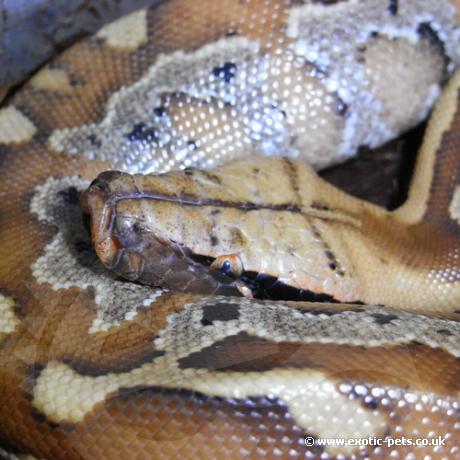

The Red Blood Python is a heavy bodied snake that reaches an adult size of 5-6 foot. They are found on the forest floor near marshes of Malaysian Peninsula, Sumatra and Indonesia.
| Origin | Malaysian Peninsula, Sumatra and Indonesia |
|---|---|
| Environment | Marshes and tropical swamps |
| Adult Size | 3-6ft |
| Suitability | Experienced keeper |
| Lifespan | Up to 20 years |
| Temperament | Aggressive |
The Red Blood Python is a large heavy snake, males are generally smaller reaching 3-5ft and the females larger at 4-6ft. These snakes are heavy and rebust that may exceed 30 pounds in weight as adults.
This is an attractive species with stunning colours and patterns. They seem to have a rusty brown/red colour with tan, black and grey markings down the side of their body. Their eyes are also colourful with red, cream and black. Caution should be taken untill tamed, they can sometimes be a little snappy.
They are found in tropical forests and near marsh land within Malaysian Peninsula, Sumarta and Indonesia.
To keep this species, experience with larger snakes is required as these are not for beginners.
Housing can be as simple or realistic as you require. Hatchlings and young snakes can be kept in plastic containers. If you use this method, plenty of air holes must be provided to allow fresh air flow. Larger snakes should be housed in vivariums, the size depends on the length of your snake. Adults should be kept in no smaller then 4ft vivariums. Height is less important than floor space for this species.
Heating the enclosure can be maintained with either a ceramic heater or spot light bulbs, using different colours for day and night. They should be connected to a thermostat and a background temperature of 78-80F should be maintained, this shouldn´t fall below 75F. A basking area must also be provided in the range of 88-90F. The next important factor is humidity, this should be within 50-60%. You can obtain this level in two ways, either place cypruss mulch as the flooring and spray with water to keep this damp, not dripping wet though. The other method is to provide a humidity hide which contains either or both cypruss mulch and sphognum moss. The snake will enter the hide when it needs a higher humidity level.
For substarte, you can use any of the following, cypruss mulch, orchid bark, beech chippings or newspaper, the latter being the cheapest and easiest to clean. They are shy snakes, so plenty of hides should be provided at both ends of the enclosure. Cork bark is cheap to purchase and easy to clean, it also comes in many different shapes and sizes. Other items can range from large flower pots to upturned cat little trays with a hole cut in them for the snake to enter.
This species of Python will start feeding on rat pups as hatchlings and slowly increase to adult rats as they grow. Babies should be fed approx every 5-7 days and adults should be fed every 10-14 days on large rats. Fresh water should also be provided and cleaned daily as you will find this species, like most snakes, will defecate in the water.